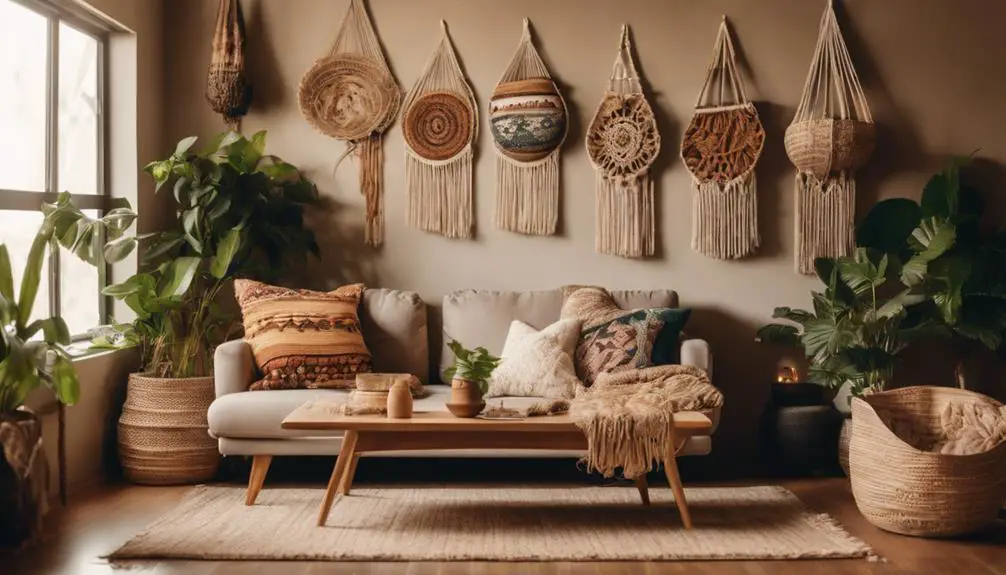As you envision your dream backyard kitchen, you're likely thinking about more than just a grill and some outdoor seating. You want a space that flows seamlessly from indoors to outdoors, where you can cook, entertain, and relax in style. But where do you start? What are the essential elements that'll make your outdoor kitchen both functional and inviting? From cooking stations to dining zones, and from materials to multifunctional designs, there's a lot to ponder. Let's break down the key components that'll help you create a backyard kitchen that's truly an extension of your home.
Essential Elements of a Backyard Kitchen

When designing a backyard kitchen, you'll need to incorporate several key components that work together to create a functional and inviting outdoor cooking space, including a cooking station, food preparation area, and dining zone.
These essential elements will help you create a harmonious Kitchen Style that reflects your personal taste and complements your home's architecture.
To achieve a seamless shift between indoors and outdoors, consider the flow of traffic and the placement of each component.
Guarantee your food preparation area is well-lit, ventilated, and equipped with necessary amenities like countertops, sinks, and storage.
The dining zone should be comfortable and inviting, with ample seating and shade.
Cooking Station Design Ideas
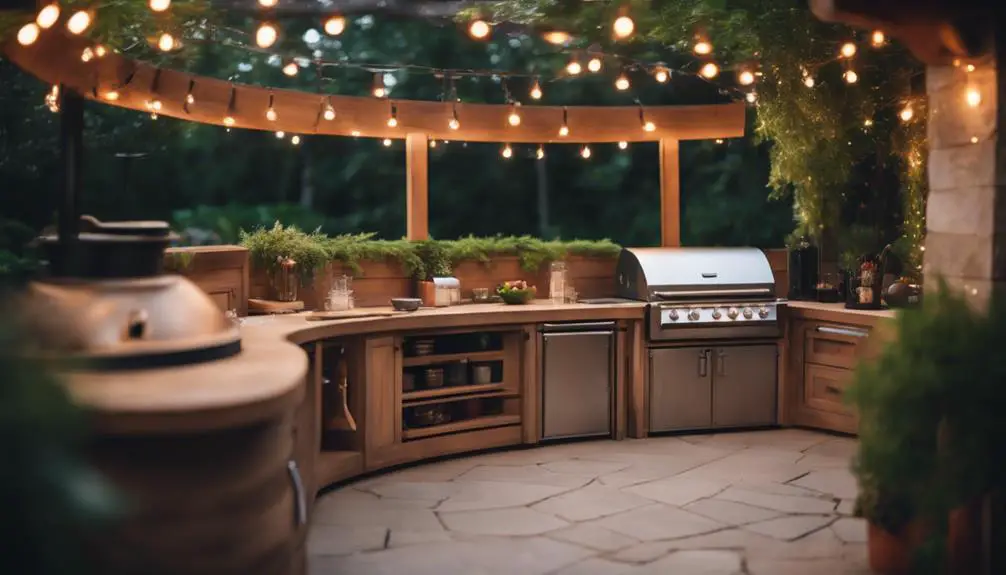
Designing an efficient cooking station involves strategically positioning your grill, cooktop, or outdoor range to optimize workflow, ensuring ample space for food preparation and convenient access to utensils, seasonings, and ingredients.
You'll want to create a cooking nook that streamlines your food prep process, allowing you to move seamlessly from one task to the next.
Consider a U-shaped layout, where your grill or cooktop is flanked by countertops and storage units, keeping everything you need within arm's reach.
This setup enables you to prep ingredients on one side, cook on the other, and store utensils and seasonings in between.
To further enhance your cooking station's functionality, incorporate features like built-in cutting boards, spice racks, and utensil holders.
These thoughtful details will elevate your outdoor cooking experience, making meal prep a breeze.
Outdoor Kitchen Layout Options
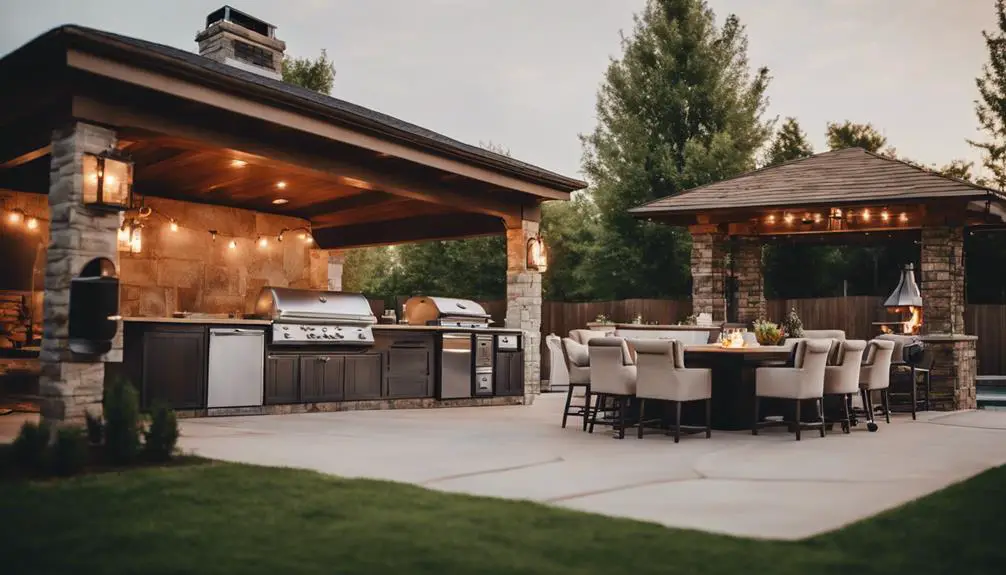
How do you envision the flow of your outdoor kitchen, considering the relationship between cooking, dining, and socializing areas? An effective layout is vital to create a seamless experience. You'll want to strategically position your cooking station, dining area, and socializing spaces to facilitate conversation and movement.
Corner spaces can be optimized with clever design tricks. Consider a corner sink or a built-in grill station to maximize functionality. Island configurations are also a great way to define different zones within your outdoor kitchen. A central island can house a cooking station, while a secondary island can serve as a bar or dining area. This configuration encourages socializing and provides ample counter space.
When planning your layout, think about the 'work triangle' concept, where your cooking station, refrigerator, and sink form the points of a triangle. This layout confirms efficient movement between tasks. Additionally, consider the traffic flow and create a clear path for guests to move through the space.
Choosing the Right Materials

You'll need to select materials that can withstand the elements and heavy use, while also aligning with your desired aesthetic and budget.
For your backyard kitchen, consider durable materials like stainless steel, concrete, and recycled glass that can resist corrosion and extreme temperatures. When material budgeting, prioritize your must-haves, such as countertops and cabinetry, and allocate your budget accordingly.
To minimize your environmental footprint, incorporate sustainable sourcing into your material selection process.
Opt for locally sourced, reclaimed, or recycled materials that reduce waste and support eco-friendly practices. For instance, repurposed wood from old barns or factories can add a unique touch to your outdoor kitchen while promoting sustainability.
Additionally, consider low-maintenance materials that require minimal upkeep, such as porcelain or ceramic tiles, to reduce your long-term expenses.
Incorporating Seating Areas
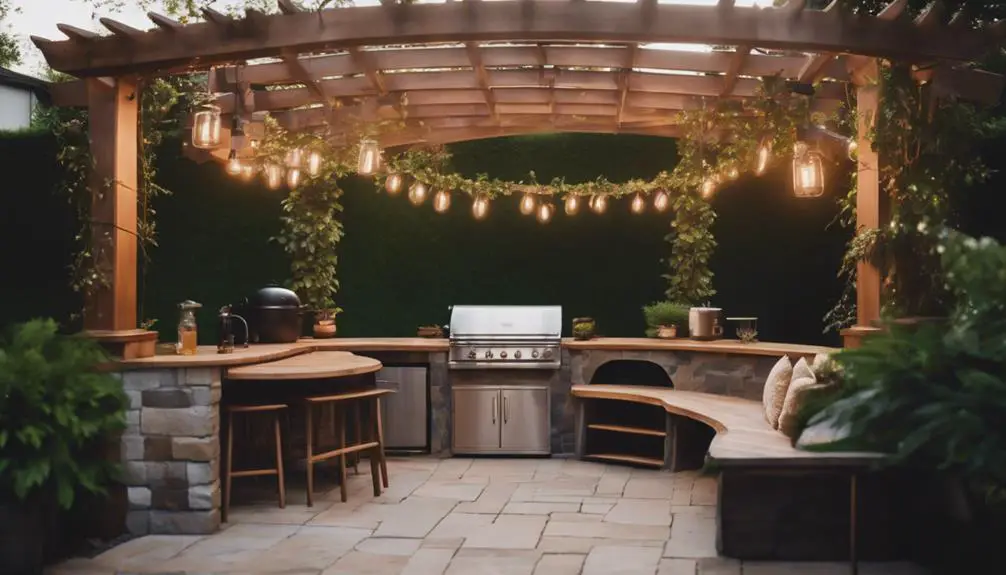
As you design your backyard kitchen, you'll want to create inviting seating areas that encourage socializing and relaxation.
You'll need to decide between cozy corner seating ideas, dining al fresco options, or a combination of both to create a functional and aesthetically pleasing space.
Cozy Corner Seating Ideas
Incorporating a cozy corner seating area into your backyard kitchen design creates a warm, inviting atmosphere that beckons you to linger over a cup of coffee or a good book.
You can create cozy nooks by utilizing dead spaces, such as the area beneath a pergola or a gazebo, and furnishing it with plush outdoor furniture.
Consider corner retreats with built-in benches, adorned with pillows and throws, to create a sense of seclusion.
To maximize comfort, incorporate elements like fire pits, outdoor heaters, or a statement piece of art to create a focal point.
You can also define the space with outdoor rugs, lanterns, or a trellis to create a sense of enclosure.
Don't forget to add some greenery, like potted plants or a living wall, to bring in a touch of nature.
By incorporating these design elements, you'll create a cozy corner seating area that's perfect for relaxation and conversation.
With a little creativity, you can transform an often-overlooked space into a haven that beckons you to stay a while.
Dining Al Fresco Options
Dining al fresco takes on a new level of sophistication when paired with thoughtfully designed seating areas that seamlessly merge functionality with aesthetics.
As you envision your outdoor dining space, consider the flow of traffic and conversation. A well-placed seating area can facilitate socializing while creating a sense of intimacy.
When selecting outdoor furniture, prioritize durability, comfort, and style. Weather-resistant materials like wicker, steel, or recycled plastic will withstand the elements.
Consider sectionals or modular pieces that can be easily rearranged to suit your gathering. Add pillows and throws in vibrant hues to inject personality into your patio decor.
Don't forget to incorporate ambient lighting, such as string lights or lanterns, to create a warm ambiance.
Relaxing Ambiance Creation
You'll want to complement your dining area with a thoughtfully designed seating arrangement that fosters relaxation, where plush cushions, soft lighting, and soothing colors converge to create a serene atmosphere.
To achieve this, consider incorporating built-in benches or sectionals with calming textures like wicker, rattan, or recycled wood. These elements will help create a cozy nook that invites lounging and conversation.
Pay attention to the color palette, opting for soothing colors like blues, greens, or neutral tones that promote relaxation. Add some greenery, like potted plants or a living wall, to bring in a natural touch.
Don't forget about lighting – string lights, lanterns, or tabletop torches can add a warm, soft glow to the space.
As you design your seating area, think about the flow of traffic and conversation. Consider creating a circular or U-shaped configuration to encourage socializing and intimacy.
Clever Storage Solutions Found

As you design your backyard kitchen, you'll want to make the most of every inch of space.
You'll need clever storage solutions that keep essentials within easy reach while maintaining a clutter-free aesthetic.
Hidden Cabinet Spaces
By incorporating hidden cabinet spaces into your backyard kitchen design, clever storage solutions emerge that keep countertops clutter-free and maintain a seamless workflow.
You'll be amazed at how these secret compartments can stow away essential items, such as cooking utensils, spices, or even a wine collection.
Concealed shelves, cleverly disguised as decorative panels or countertops, provide additional storage for infrequently used items like special occasion dishes or kitchen gadgets.
Incorporating hidden cabinet spaces allows you to create a visually appealing kitchen that's both functional and organized.
You can design cabinets with slide-out drawers or pull-down shelves to access frequently used items quickly.
Even the most compact backyard kitchens can benefit from hidden storage solutions, making the most of available space.
Imagine having a clutter-free kitchen where everything has its designated place, and you can focus on cooking up a storm.
Maximizing Vertical Areas
Incorporating hidden cabinet spaces has streamlined your backyard kitchen's workflow, and now it's time to capitalize on another often-underutilized asset: the vertical areas surrounding your cooking station, where clever storage solutions await discovery.
By installing vertical shelving, you can store infrequently used items like special occasion dishes, cookbooks, or small appliances, keeping them out of the way yet still accessible. This will free up valuable counter space and create a more organized, efficient cooking environment.
Consider adding a wall garden, which not only provides additional storage for herbs, spices, or other kitchen essentials but also brings a touch of greenery to your outdoor space.
This innovative design element can also serve as a natural room divider or visual screen, creating a sense of separation between your cooking station and adjacent areas.
Designing for Function and Flow
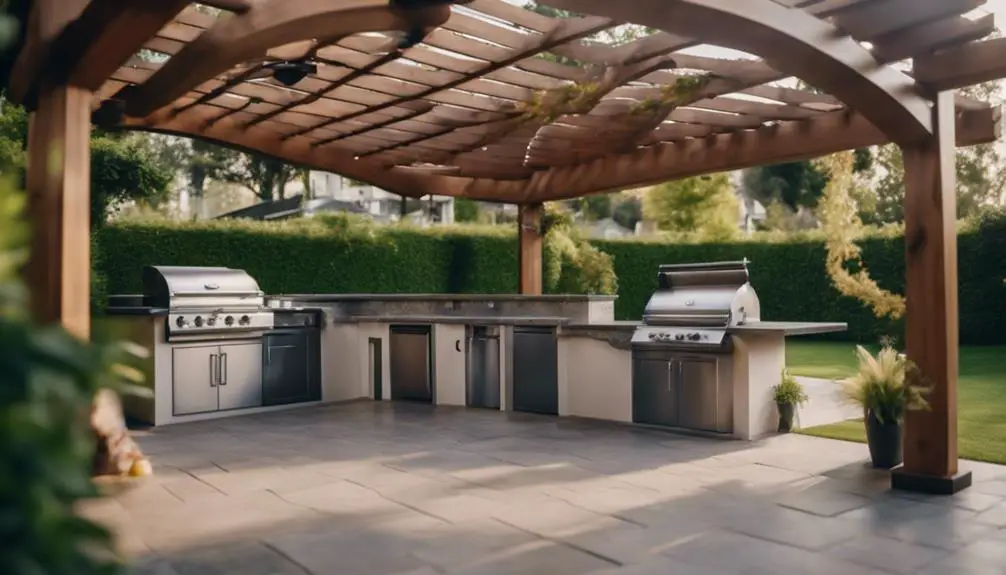
Efficiency converges with aesthetics when you intentionally allocate space for each functional zone in your backyard kitchen, ensuring a seamless flow between cooking, dining, and socializing areas.
By strategically positioning your Work Triangle – the sink, cooktop, and refrigerator – you'll minimize walking distances and optimize workflow.
Divide your outdoor space into distinct Activity Zones, each serving a specific purpose. The Prep Zone, for instance, might feature a sink, countertops, and storage for utensils and ingredients.
The Cooking Zone could center around the grill or cooktop, with adjacent countertops and storage for cooking essentials.
As you move through your backyard kitchen, you'll appreciate the fluid shift between zones.
The Dining Zone, perhaps featuring a built-in banquette or outdoor dining set, should be situated near the Cooking Zone to facilitate serving and socializing.
Consider incorporating a Social Zone, complete with a fire pit or outdoor lounge, to encourage relaxation and conversation.
Adding Ambiance With Lighting

You'll set the tone for your backyard kitchen with a thoughtful lighting plan that combines task, ambient, and accent lighting to create a warm, inviting atmosphere.
By balancing these three elements, you'll create a space that's both functional and visually stunning.
Task lighting, such as under-counter LED strips, illuminates cooking surfaces and prep areas, ensuring you can see what you're doing.
Ambient lighting, like string lights or lanterns, sets the mood and creates a sense of warmth.
Accent lighting, including spotlights or uplighting, highlights focal points like a statement piece of art or a stunning water feature.
Consider incorporating Moonlight Illumination, which uses a combination of blue and yellow LED lights to mimic the soft glow of the moon.
Alternatively, achieve a Twilight Glow by using warm-toned LED lights that simulate the soft, golden light of dusk.
Backyard Kitchen Countertop Options

Three primary countertop options – natural stone, concrete, and recycled glass – offer distinct visual and functional benefits for your backyard kitchen.
You'll want to weigh each material's unique characteristics to determine which best suits your outdoor space.
Natural stone countertops, such as granite or marble, exude luxury and sophistication, while also providing exceptional surface durability.
Concrete countertops, on the other hand, offer a high degree of customization, allowing you to incorporate unique aggregate materials or colors.
Recycled glass countertops, made from crushed glass and resin, provide an eco-friendly option with a modern aesthetic.
When selecting a countertop style, ponder the overall aesthetic you want to achieve in your backyard kitchen.
Do you prefer a sleek, modern look or a more rustic, natural appearance?
Your choice will have a significant impact on the overall ambiance of your outdoor space.
Selecting the Perfect Grill
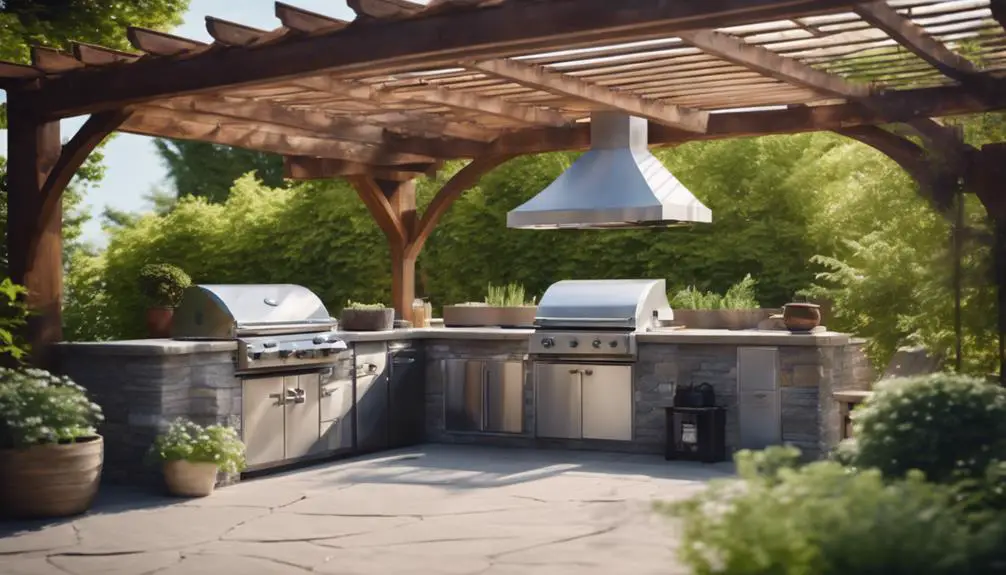
With your backyard kitchen's countertops in place, it's time to focus on the star of the show: the grill, which will be the epicenter of your outdoor cooking experience.
When selecting the perfect grill, you'll want to ponder factors that guarantee seamless performance and low maintenance. Look for grills with high fuel efficiency ratings to minimize waste and reduce your environmental footprint.
You'll also want to prioritize grill maintenance tips, such as frequent cleaning and lubrication, to prolong the lifespan of your grill.
Visualize the sizzle and aroma of perfectly grilled meals, and ponder the type of grill that will best achieve your culinary goals.
Will you opt for a gas, charcoal, or electric grill? Each has its pros and cons, so weigh your options carefully.
Ponder the size of your grill, too – will you need ample space for large gatherings or intimate family dinners?
Creating a Focal Point Feature
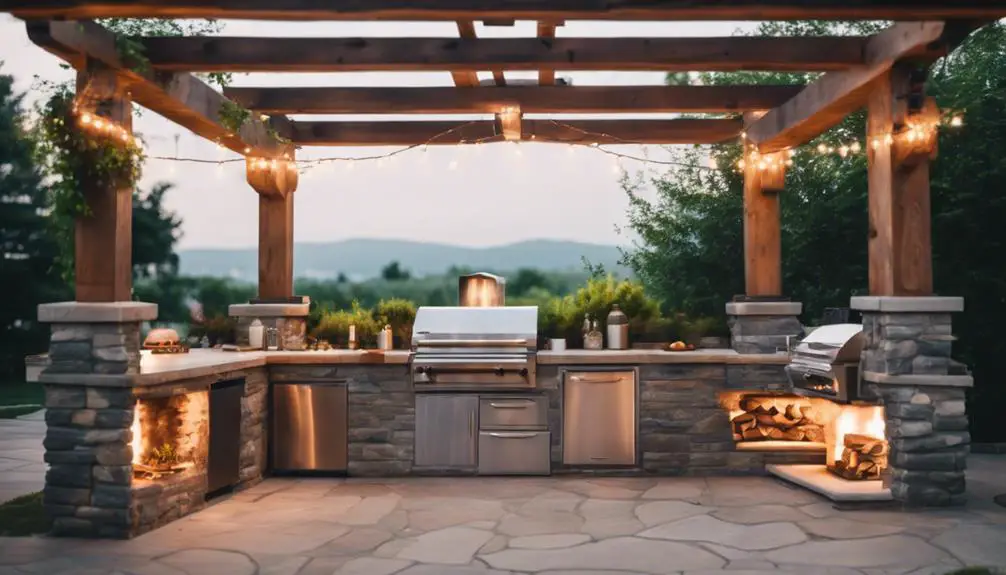
Beyond the grill, a thoughtfully designed focal point feature can elevate your backyard kitchen's ambiance, drawing guests in and creating a sense of warmth and invitation.
This visual anchor can be a stunning piece of Focal Point Art, such as a statement fire pit, a show-stopping water feature, or a vibrant outdoor sculpture.
By incorporating a focal point feature, you'll create a sense of visual hierarchy, guiding the eye towards the most striking elements of your outdoor space.
Consider the scale, material, and style of your focal point to guarantee it harmonizes with the surrounding landscape and architecture.
To maximize visual impact, position your focal point feature in a prominent location, such as near the grill or dining area, where it can be easily admired.
Maximizing Space With Multifunctional
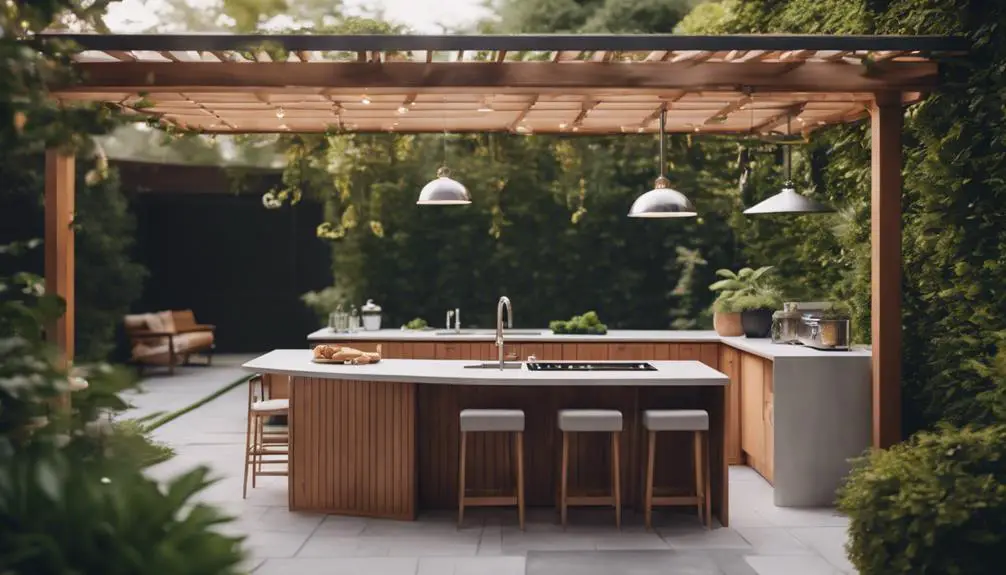
By incorporating multifunctional elements, you can cleverly repurpose areas of your backyard kitchen, revealing hidden potential and streamlining your outdoor space.
This approach allows you to create a functional and efficient kitchen that caters to your needs without sacrificing style.
Space savers, such as multi-use furniture, are a great way to maximize your outdoor space.
For instance, consider installing a built-in bench with storage or a dining table with built-in planters.
These innovative designs not only save space but also add a touch of elegance to your backyard kitchen.
When selecting multifunctional elements, consider your lifestyle and entertaining habits.
Do you frequently host dinner parties or prefer intimate gatherings?
This will help you determine the type of multi-use furniture that best suits your needs.
Additionally, think about the flow of your outdoor space and how different elements can work together to create a cohesive look.
Incorporating Water Features Effectively
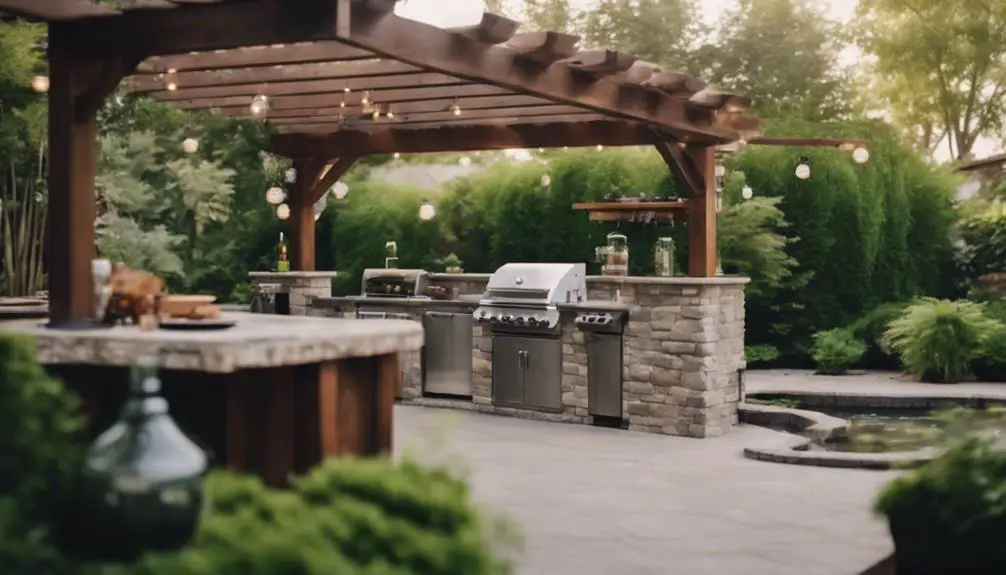
As you design your backyard kitchen, you'll want to strategically place water features to maximize their visual and auditory impact.
You'll need to weigh the placement of these features to create a sense of serenity, taking into account the sound of running water and its effect on the overall ambiance.
Water Feature Placement
When designing your backyard kitchen, carefully positioning a water feature near the cooking and dining areas can create a soothing ambiance that draws guests in and encourages them to linger.
You'll want to ponder the visual flow of your outdoor space when deciding where to place your water feature. For instance, a waterfall placement near the cooking area can create a sense of continuity, while a fountain near the dining area can add a touch of elegance.
Fountain styles vary, ranging from modern and sleek to traditional and ornate.
Choose a style that complements your backyard kitchen's aesthetic. Weigh the sound, too – a gentle trickle or a soft gurgle can enhance the ambiance.
When placing your water feature, think about the surrounding landscape.
Will you incorporate natural elements like rocks or plants, or will you opt for a more modern, sleek design?
Water Sound Serenity
Strategically incorporating water features into your backyard kitchen design can amplify the calming effect of the water's sound, creating a serene atmosphere that envelops your guests.
The gentle lapping of water against stone or concrete can transport your guests to a state of relaxation, making them feel like they're in a spa. This is due to the principles of water therapy, which leverage the psychological benefits of water sounds to reduce stress and anxiety.
To maximize this effect, consider positioning your water feature in a way that creates a focal point in your backyard kitchen. For instance, a small fountain placed near the dining area can create a soothing background noise that complements conversation.
You can also experiment with different fountain sounds to find the one that resonates with you the most. By thoughtfully incorporating water features into your design, you'll create an immersive experience that will leave your guests feeling refreshed and rejuvenated.
Visual Flow Harmony
To create visual flow harmony in your backyard kitchen design, strategically position water features to guide the eye through the space, unifying disparate elements and creating a sense of cohesion.
This deliberate placement guarantees a smooth shift between areas, fostering a sense of Visual Balance. As you design, consider the Harmony Principles of contrast, alignment, and proximity to create a visually appealing flow.
For instance, place a small fountain near a seating area to draw the eye towards the gathering space, then use a meandering stream or rill to lead the eye to a nearby herb garden or cooking station.
The gentle sound and movement of water will create a sense of continuity, tying together the various elements of your backyard kitchen. By carefully incorporating water features, you'll create a harmonious visual flow that invites relaxation and exploration.
As you refine your design, remember to balance visual weight, texture, and color to maintain a sense of equilibrium, guaranteeing your backyard kitchen is a true oasis.
Frequently Asked Questions
Can I Install a Backyard Kitchen With a Small Budget?
"When working with budget constraints, you'll need to prioritize your financial priorities. Identify must-haves and nice-to-haves, then allocate resources accordingly, getting creative with DIY elements and cost-effective materials to achieve your vision within your means."
How Do I Protect My Outdoor Kitchen From Harsh Weather?
When building an outdoor space, you'll want to shield it from the elements. Choose weatherproof materials, and commit to seasonal maintenance to guarantee your investment lasts.
Are Outdoor Kitchens a Good Investment for Resale Value?
When considering a home upgrade, you'll want to know if it pays off in resale value. Generally, outdoor kitchens can boost your Return on Investment, especially if they align with Neighborhood Trends, making your property stand out in a competitive market.
Can I DIY a Backyard Kitchen or Do I Need a Professional?
When tackling a DIY project, you'll face design considerations and layout challenges, so unless you're an expert, it's wise to hire a pro to guarantee a seamless, functional space that meets your needs and local building codes.
How Do I Keep Pests Out of My Outdoor Kitchen and Food?
When preparing outdoor meals, you'll want to prioritize pest control methods. Guarantee outdoor sanitation by sealing food in airtight containers, regularly cleaning surfaces, and installing screens to prevent unwanted critters from crashing your culinary party.
Conclusion
As you finalize your backyard kitchen design, remember to strike a balance between aesthetics and functionality.
Visualize the flow of traffic, the harmony of materials, and the incorporation of essential elements.
By doing so, you'll create an outdoor space that seamlessly extends your indoor living area, inviting relaxation, entertainment, and culinary exploration.



